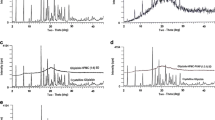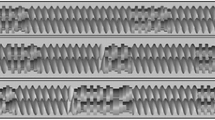Abstract
The stability and dissolution properties of griseofulvin binary and ternary solid dispersions were evaluated. Solid dispersions of griseofulvin and hydroxypropyl methylcellulose acetate succinate (HPMCAS) were prepared using the spray drying method. A third polymer, poly[N-(2-hydroxypropyl)methacrylate] (PHPMA), was incorporated to investigate its effect on the interaction of griseofulvin with HPMCAS. In this case, HPMCAS can form H bonds with griseofulvin directly; the addition of PHPMA to the solid dispersion may enhance the stability of the amorphous griseofulvin due to greater interaction with griseofulvin. The X-ray powder diffraction results showed that griseofulvin (binary and ternary solid dispersions) remained amorphous for more than 19 months stored at 85% RH compared with the spray-dried griseofulvin which crystallized totally within 24 h at ambient conditions. The Fourier transform infrared scan showed that griseofulvin carbonyl group formed hydrogen bonds with the hydroxyl group in the HPMCAS, which could explain the extended stability of the drug. Further broadening in the peak could be seen when PHPMA was added to the solid dispersion, which indicates stronger interaction. The glass transition temperatures increased in the ternary solid dispersions regardless of HPMCAS grade. The dissolution rate of the drug in the solid dispersion (both binary and ternary) has significantly increased when compared with the dissolution profile of the spray-dried griseofulvin. These results reveal significant stability of the amorphous form due to the hydrogen bond formation with the polymer. The addition of the third polymer improved the stability but had a minor impact on dissolution.





Similar content being viewed by others
References
Elliott PN, Ford JL, Chan KK. The effect of incorporation of indomethacin with polyethylene glycol 6000 in a solid dispersion on its in vivo properties in the rat. Agents Actions. 1984;15:367–70.
Park MJ, Ren S, Lee BJ. In vitro and in vivo comparative study of itraconazole bioavailability when formulated in highly soluble self-emulsifying system and in solid dispersion. Biopharm Drug Dispos. 2007;28:199–207.
Tashtoush BM, Al-Qashi ZS, Najib NM. In vitro and in vivo evaluation of glibenclamide in solid dispersion systems. Drug Dev Ind Pharm. 2004;30:601–7.
Amidon GL, Lennernas H, Shah VP, Crison JR. A theoretical basis for a biopharmaceutic drug classification: the correlation of in vitro drug product dissolution and in vivo bioavailability. Pharm Res. 1995;12:413–20.
Chowdary KP, Rao SS. Investigation of dissolution enhancement of itraconazole by solid dispersion in superdisintegrants. Drug Dev Ind Pharm. 2000;26:1207–11.
Chiou WL, Riegelman S. Pharmaceutical applications of solid dispersion systems. J Pharm Sci. 1971;60:1281–302.
Fujii M, Okada H, Shibata Y, Teramachi H, Kondoh M, Watanabe Y. Preparation, characterization, and tableting of a solid dispersion of indomethacin with crospovidone. Int J Pharm. 2005;293:145–53.
Sethia S, Squillante E. Solid dispersion of carbamazepine in PVP K30 by conventional solvent evaporation and supercritical methods. Int J Pharm. 2004;272:1–10.
Chokshi RJ, Zia H, Sandhu HK, Shah NH, Malick WA. Improving the dissolution rate of poorly water soluble drug by solid dispersion and solid solution: pros and cons. Drug Deliv. 2007;14:33–45.
Buckton G, Brocchini S, Fletcher J, Al-Obaidi H. Solid dispersion of hydrophobic bioactive. 2006; PCT/GB2006/000467
Al-Obaidi H, Brocchini S, and Buckton G. Anomalous properties of spray dried solid dispersions. J Pharm Sci. 2009. doi:10.1002/jps.21782.
Hilden LR, Morris KR. Physics of amorphous solids. J Pharm Sci. 2004;93:3–12.
Nair R, Nyamweya N, Gonen S, Martinez-Miranda LJ, Hoag SW. Influence of various drugs on the glass transition temperature of poly(vinylpyrrolidone): a thermodynamic and spectroscopic investigation. Int J Pharm. 2001;225:83–96.
Kuo SW, Shih CC, Shieh JS, Chang FC. Specific interactions in miscible polymer blends of poly(2-hydroxypropyl methacrylate) with polyvinylpyrrolidone. Polym Int. 2004;53:218–24.
Taylor LS, Zografi G. Sugar–polymer hydrogen bond interactions in lyophilized amorphous mixtures. J Pharm Sci. 1998;87:1615–21.
Cilurzo F, Minghetti P, Casiraghi A, Montanari L. Characterization of nifedipine solid dispersions. Int J Pharm. 2002;242:313–7.
Mosharraf M, Nystrom C. Apparent solubility of drugs in partially crystalline systems. Drug Dev Ind Pharm. 2003;29:603–22.
Takano R, Furumoto K, Shiraki K, Takata N, Hayashi Y, Aso Y, et al. Rate-limiting steps of oral absorption for poorly water-soluble drugs in dogs; prediction from a miniscale dissolution test and a physiologically-based computer simulation. Pharm Res. 2008;25:2334–44.
Acknowledgments
The authors would like to thank the School of Pharmacy/University of London for funding the project.
Author information
Authors and Affiliations
Corresponding author
Rights and permissions
About this article
Cite this article
Al-Obaidi, H., Buckton, G. Evaluation of Griseofulvin Binary and Ternary Solid Dispersions with HPMCAS. AAPS PharmSciTech 10, 1172–1177 (2009). https://doi.org/10.1208/s12249-009-9319-x
Received:
Accepted:
Published:
Issue Date:
DOI: https://doi.org/10.1208/s12249-009-9319-x




